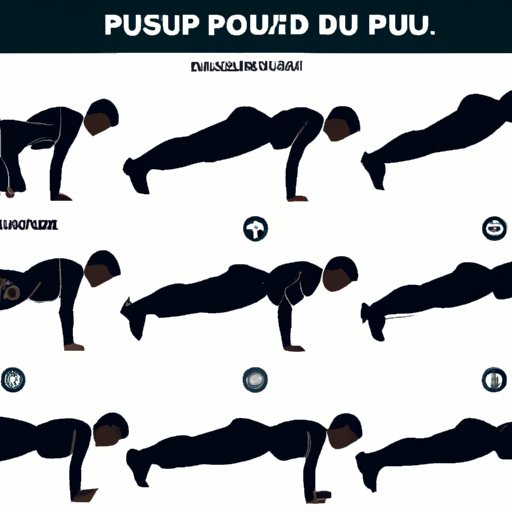
I. Introduction
Push-ups are a fundamental exercise that targets various muscle groups and helps build upper body strength, core stability, and endurance. They are an exercise that can be done anywhere and do not require any equipment. Learning to do a proper push-up is important for any fitness level, from beginners to advanced athletes. This article aims to provide a step-by-step guide to mastering the proper technique of a push-up, exploring different variations and the benefits of incorporating them into a consistent workout routine.
II. Start with the Basics
Before exploring different variations and common mistakes, it’s important to establish the proper technique of a push-up. A push-up is a full-body exercise that targets the chest, triceps, shoulders, core, and back. Here’s the breakdown of the proper technique for a push-up:
A. Body Positioning
– Start in a plank position with your hands shoulder-width apart, fingers pointing forward, and arms straight.
– Keep your head, neck, and spine in a neutral position.
– Engage your core by squeezing your glutes and pulling your belly button toward your spine.
– Keep your feet together and toes curled under, so your weight is balanced between your hands and feet.
B. Hand and Foot Placement
– Your hands should be slightly wider than shoulder-width apart to ensure proper alignment of the elbows and wrists.
– Your feet should be close together, but not touching.
C. Range of Motion
– Lower your body until your chest almost touches the ground.
– Keep your elbows close to your sides as you lower your body.
– Push yourself back up to the starting position while keeping your body in a straight line.
– Repeat for desired reps or time.
D. Common Mistakes to Avoid
– Avoid lifting your hips too high or sagging your lower back, as this puts pressure on the lower back.
– Do not let your elbows flare out to the sides, as this puts unnecessary strain on the shoulders.
– Do not let your head drop, as this places pressure on the neck.
III. Different Variations
Once the proper form is established, explore different variations of a push-up that can target different muscle groups and add variety to your routine. Here are a few variations of push-ups to try:
A. Narrow Hand Placement Push-Up
– Place your hands close to each other, allowing your index fingers and thumbs to touch.
– This variation targets the triceps muscles, providing an effective exercise for the back of the arms.
B. Wide Hand Placement Push-Up
– Place your hands wider than shoulder-width apart.
– This variation targets the chest muscles, providing an effective exercise for the upper chest.
C. Decline Push-Up
– Place your feet on an elevated surface, such as a bench or step.
– This variation targets the upper chest and shoulders, offering a more challenging exercise for advanced athletes.
D. Incline Push-Up
– Place your hands on an elevated surface, such as a bench or step.
– This variation targets the lower chest and triceps, providing a good exercise for beginners or those with weaker upper body strength.
IV. Common Mistakes to Avoid
Proper form is key when doing a push-up to reduce the risk of injury and see optimal results. Here are some common mistakes to avoid:
– Not engaging the core: to keep your body stable, engage your core muscles.
– Holding your breath: breathe in while lowering your body down and exhale when pushing your body back up.
– Flaring your elbows: keep your elbows close to your sides to avoid putting unnecessary strain on your shoulders.
V. Importance of Breathing
Breathing plays an important role in doing a proper push-up. Proper breathing technique helps to increase endurance and stamina, improves oxygen flow, and provides more energy to support your muscles. Here’s how to coordinate your breathing while doing a push-up:
– Inhale while lowering your body down to the ground.
– Exhale while pushing your body back up to the starting position.
VI. Importance of Consistency
Incorporating push-ups into your daily workout routine can provide numerous benefits for your physical health. Push-ups not only build upper body strength but also help build core strength, improve endurance and posture, and increase metabolism. Consistently doing push-ups regularly also ensures that you maintain progress and see the results you desire.
VII. Putting it into Practice
To incorporate push-ups into your daily routine, follow this sample push-up workout routine:
– 10 narrow hand placement push-ups
– 10 wide hand placement push-ups
– 10 regular push-ups
– 10 decline push-ups
– 10 incline push-ups
Repeat the set 3-5 times, or for however many sets you desire.
You can also incorporate push-ups into your daily life by doing a set before getting out of bed, during commercial breaks, or using them as a warm-up before other exercises.
VIII. Conclusion
Push-ups are a simple yet effective exercise that targets various muscle groups, improves posture, and provides numerous health benefits. By mastering the proper technique, exploring different variations, and avoiding common mistakes, you can enhance your workout routine and see optimal results. Remember to breathe properly, stay consistent and have fun with your push-up journey. Incorporate push-ups into your daily routine, and make them a part of a healthy and active lifestyle.





